Like the Tet offensive in Vietnam, the political fallout caused the usual sea change in the US bringing the Somalia adventure to an end. Paul Watson, though not a professional photographer, who won the Pulitzer Prize and Robert Capa medal, for his photos of US troops dragged through the streets did contribute significantly to the political system implosion and scapegoat witch hunt that ensued.
The next day, images of hostage Michael Durant, further traumatized American public [woke] opinion.
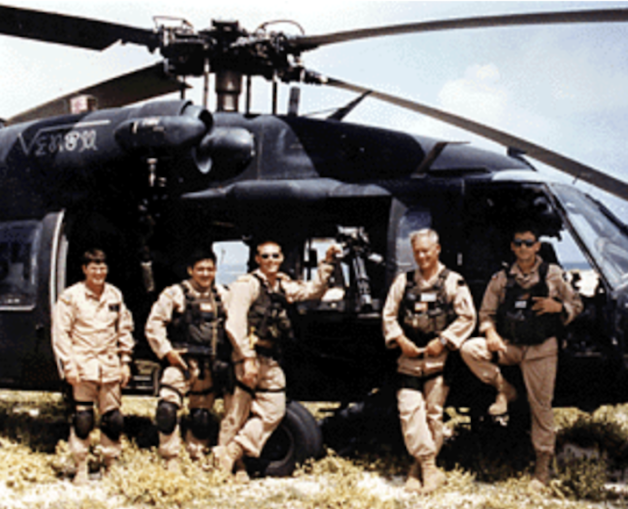
The crew of Super 64,
U.S. Army Ranger Phil Lepre – Public domain
The strength of “independent” media images first precipitated US military involvement, now the images would precipitate the first US retreat since Vietnam.
BJ Bill
A rarity back then, non-existent now, CNN proved faster than intelligence channels and Clinton was forced to react [waffle and lie]. As more details from independent journalists [and some aid workers on the ground] emerged, the call to pull out tsunamied. Aidid had vowed to “double and triple” efforts to kidnap and kill Americans. Time Magazine accurately reflected the question on most American lips who still thought US troops were feeding starving kids.
Clinton, as usual, seemed surprised and out of touch with the turn of events, despite having personally authorised the Task Force Ranger and Delta raids. Entering full-on lying politician mode, he personally told families of killed Rangers that, “He was mystified that the raid had been attempted … because Washington was shifting its policy.” He was upset at the death toll [US not Somali] stating, “This is stupid, how could they be going after Aidid when we’re working on the political end?”
Post the images of dead US troops on the TV [and too many tricky questions he didn’t want to answer], Clinton went into full Monica Lewinski mode, “It curdles the stomach of every American to see that,” then into full lie mode, “It makes me sick and it’s reprehensible since all Americans ever did was go there to try and save children from starving, reopen hospitals and schools and give people a safe place to sleep.”
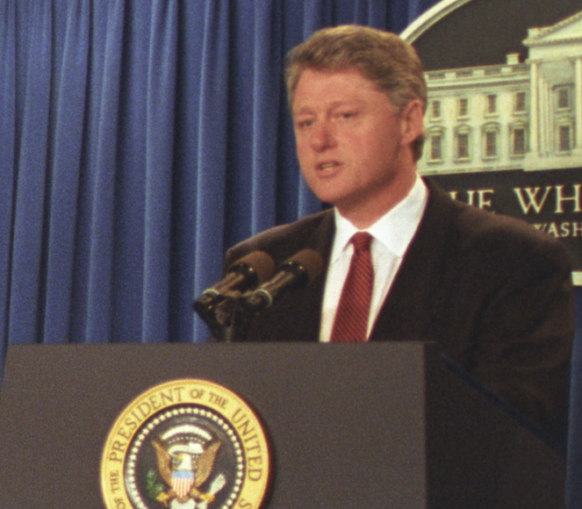
President Bill Clinton at the podium,
White House Photograph Office – Public domain
Withdrawal [and NWO Phase I end]
The US withdrawal was couched in terms serving as a political sop for both the UN and US public. Boutros Ghali saw the weakening US political will as “cut and run”, when he wanted the US, as the strongest link in the “peace enforcement” strategy to continue. The retreat was gauged to convince the US public troops would not stay more than six months. Though to protect the retreat, troop strength would need to be doubled to protect the retreat. Justifying this policy change, Clinton now in full blatant lie mode [given he wasn’t president at the time] stated, “In our nation’s best tradition delivering the Restore Hope famine relief effort, we saved close to one million lives. And make no mistake about it, we came to Somalia to rescue innocent people in a burning house. We’ve nearly put the fire out, but some smouldering embers remain. If we leave them now, those embers will reignite into flames and people will die again.”
Echoing the language of Nixon in 1969 [and covering his NWO agenda at the same time] over premature withdrawal [from Vietnam-Somalia], “Would result in a collapse of confidence in American leadership.” Clinton further added, “If we were to leave today, we know what would happen… our leadership in world affairs would be undermined at the very time when people are looking to America to help promote peace and freedom in the post-Cold War world. All around the world, aggressors, thugs, and terrorists will conclude the best way to get us to change our policy is to kill our people. It would be open season on Americans.” Somalia’s “thugs”, of course, had come to this conclusion way before.
US Amb Oakley
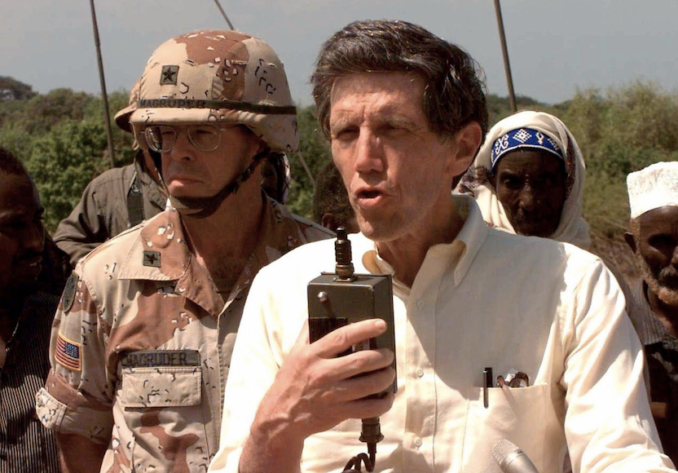
Special Envoy to Somalia, Ambassador Robert Oakley,
PHCM Terry Mitchell – Public domain
Having “negotiated” the safe arrival of US troops in December 92, a couple of days after the firefight, Oakley was wheeled out to handle the “gunboat diplomacy.” Oakley made it clear to Aidid, mistakes had been made shifting the UN mission from rebuilding to revenge. Oakley in full-on diplomat mode inferred to Aidid, “Give Durant back, or we will give you one hour to leave the city centre or we’ll flatten the whole of Mogadishu. They would love that in the US because no one cares if you die or your clan dies, you’re seen as murderers.”
Ten days later, Aidid released Durant in exchange for the US ordering the UN for the release of Osman Ato and others detained. The Somalis were held for another two months.
After the release of Durant, Clinton changed his tone of reconciliation overnight, “The new boost in US troops numbers would re-establish security, street by street and open lines of communication for relief workers.
We’re not bringing tanks to feed children, we want to scare the Somalis badly, and be prepared to kill them if we have to. It is provocative yes, but we’re here to do business.” In preparation for more conflict, US psyop-ops unit even printed fresh leaflets declaring “bandit Aidid” was blocking peace. Aidid made preparations for round two.
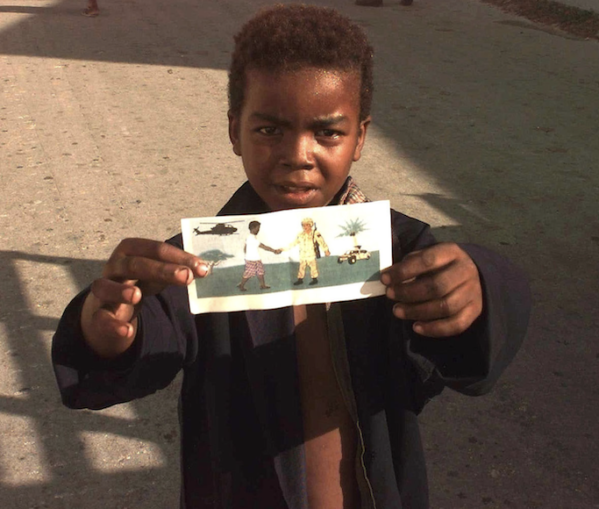
PSYOPS leaflet Somalia 1993,
TSGT Perry Heimer – Public domain
Oakley, still waffling, tried sugarcoating the Aidid agenda, “The mission had become distorted because the UN [and US] had already decided on an individual; and upon an entire subclan for guilt. The US additional troops strength was only meant to protect “foreign” troops already there, and I will use it in the cause of peace, not in the cause of war.”
Entering into realpolitik and galling for US troops involved in the hunt, was the rehabilitation of their nemesis Aidid, the “great threat to world peace.” The UNSC dropped the arrest warrant and Aidid came out of hibernation. Aidid had spent 97 days avoiding 30,000 troops.
The galling moment sunk into the US diplomatic corps and UN reps when Aidid was provided with a flight to Addis Ababa in early December 1993. He’d refused to travel on a UN plane, but agreed to be transported on a US transport, which had been used as part of the air armada to hunt him down. Aidid’s arrival in Addis, the Stars and Stripes plainly visible on the fuselage, ignited the usual woke firestorm in the US, but also confirmed the end of the war. With the manhunt over, Aidid could claim victory. The US were forced to accept that he “must” be part of any solution to the “Somalia crisis.” The White House changed tac and referred to him as a “clan leader with a substantial constituency in Somalia.”
SRSG Howe
With Aidid’s “political career” resuscitated, the architect of the manhunt, SRSG [Admiral] Howe, left Somalia quietly in March 1994 and never returned. After hearing of his dismissal on the House of Saville World Service radio, he sent his final message to Somalia from UNHQ.
He left his aides in Somalia to pack his personal effects for onward shipment. That said the blood feud debt remains as part of the cultural revenge, with Howe top of the list. Anyone in doubt of revenge, the tale of Somali Smith resonates.
In 1947, the British District commissioner of Las Anod [northern Somalia], was Colonel Smith. He carried out a court order to seize camels from a bandit of the Majerteen clan. Some Somalis were killed in the ensuing fight. In 1967, having been abroad for many years, “Somali Smith” asked a friend if it would be safe to return briefly to Somalia with his Somali wife. They decided that, as so much time had elapsed, it probably was. The day after his arrival, at the door of his hotel room, Somali Smith was stabbed to death by the son of one of the men he had killed in the 1947 raid.
Having retired from military service, Howe lives in Jacksonville, Florida. He is executive director of the Arthur Vining Davis Foundation, one of the larger “grant-providers” in the US that, their literature states, are a “philanthropic institution strongly committed to the honourable service to society”.

LTG Thomas M. Montgomery, US Army Retired,
Scott Davies – Public domain
Though Montgomery might have been the natural fall guy when the mission fell apart at the seams, he claimed he did not act without direction from above. To prevent him from spilling the beans and protecting the “top brass”, he was given a third star and promoted to a comfortable NATO job in Brussels before retiring.
US Envoy Robert Gosende
Gosende who also pushed hard to remove Aidid, was sacked immediately after the battle for his tough stance, and later re-emerged as a public affairs officer at the US Embassy in Moscow. On retirement he is still an associate vice chancellor for international programs for the State University of New York, residing in Guilderland NY.
April Glaspie
Also, among the hardliners, Glaspie later joined the UN Relief and Works Agency [UNRWA] supposedly working for Palestinians in Gaza. With her previous diplomacy fallout with Saddam Hussein and Aidid, it was deemed, “She has a trouble with men”. Questions about Glaspie’s performance as U.S. ambassador to Iraq had a negative effect on her career. She was never offered another ambassadorship or any other position that required confirmation by the U.S. Congress. Glaspie served in several lower-level diplomatic posts, most famously in Somalia, over the next ten years, but also included posting as U.S. consul general in Cape Town, South Africa. She retired from the State Department around 2002.
Les Aspin Defence Secretary

Les Aspin, former United States Secretary of Defense,
Department of Defense – Public domain
Moving up the political food chain, next on the chopping board was Def Sec Aspin who had conveniently turned down a request for more armour, was forced to resign and was the obvious political casualty. His decision to reject the use of armour in September 1993 was made when the Clinton Administration was under pressure to act in Bosnia, when Congress would have been loath to approve any more hardware for Somalia. Though sending in tanks would have been seen as a dangerous escalation, Aspin nevertheless became the whipping boy after the battle.
Madelaine K Albright

Madeleine Albright, official Secretary of State portrait,
United States Department of State – Public domain
Following the 1992 presidential election, Albright helped assemble Clinton’s National Security Council. She was appointed US ambassador to the UN from 1993 to 1997, who presented the ‘Aidid manhunt’ resolution within hours of the slaughter of the Pakistani troops, eventually climbing up the political ladder before being elevated to secretary of state. Secretary Albright served in that capacity until President Clinton left office in 2001. Before assuming the Secretary of State post, she would be instrumental in ensuring the US lied on its involvement backing the “Tutsi” invasion of Rwanda and their role in the 1994 genocide. As Clinton’s “hawk” of rank, she continued singling out, according to her view, unsavoury leaders; Saddam Hussein (1998), Yugoslavia’s Slobodan Milosevic (1999) for personal demonisation and military attack.
Albright’s point of reference in all the above campaigns was her status as “daughter of Munich”, one of the many Czech families who fled Naziism. The result was her hard-nosed rejection of any policy of appeasement and the belief that crucial moments of diplomacy required tough lines drawn and a credible military threat to enforce them. Top Russian officials labelled her “Madame War”.
The UN inquiry into the disastrous escalation of Somalia fighting, however, found that the Security Council resolution calling for Aidid’s arrest – the vote Albright wanted to be as tough as possible, even before any investigation into the 5th June killings – guaranteed further violence with senior UNHQ aides confirming, “The resolution resulted in a virtual war situation between UNOSOM II and the SNA, as the two sides attacked each other over a period of four months.”
Bill Clinton
At the top of the political tree, Clinton had authorised the Task Force/Delta operations, but later, inexplicably, said he was “mystified” that the 3-4th October raid had been carried out. As the real realisation grew within the administration that Somalia had become the biggest military misadventure since US “peacekeepers” were sent to Lebanon in 1983. Clinton’s role was masked until the debacle was safely overshadowed by “other presidential concerns” in Haiti and at home. Enough top-level smoke screens were even provided for Haiti when it became well-known of the behind-the-scenes role already taken by the Clinton Foundation which still is involved today.
For Somalia and his version of NWO/woke politics, the truth for Clinton was tougher to stomach because, “As a young anti-Vietnam activist, he had written that he “loathed” US Army tactics that often killed women and children in Vietnam.” ‘Now he felt responsible’ for the same tactics. The same, internal report described how an elaborate “damage limitation programme” managed to fog the public perception of Clinton’s responsibility.
If there was still any doubt remaining about institutional responsibility, US politicians et al perpetuated the greatest myth of all: that the UN was to blame for dragging the US into “mission impossible” in Somalia and for “moving the goalposts” without alerting the US. The myth holds that it was the UN that laid down the Mogadishu line. Clinton struck out at the UN, [hiding the NWO agenda at the same time] accusing it of incompetence and endangering US lives, and implied – two days before the day of the Ranger’s battle – that the US was drawn into deep waters of nation building against its will: “The UN cannot simply become engaged in every one of the world’s conflicts. If the American people are to say “yes” to peacekeeping, the UN must know when to say “no”.”
The UN inquiry confirmed many major operations under the banner of UNOSOM were totally outside the command and control of the UN, though the repercussion impacted crucially and negatively on the mission. The question arose: “If operations were not under UNOSOM II, were they authorised by the UN? If they were not, then the SNA’s right to defend itself was entirely appropriate.” The collective amnesia in the White House, State and Pentagon remained.
Wider internal damage, this time in US foreign policy, was the impact of the Somalia humiliation had on US willingness to engage in multilateral peace operations abroad. The final Presidential Decision Directive 25 was signed on 3rd May 1994, a draconian version that imposed a host of strict conditions on any future US peacekeeping operation: “There had to be US interest at stake; the mission had to be clearly defined in size, scope, and duration; peace among all parties had to be fully evident; and there had to be sufficient political will and a clearly identifiable ‘exit strategy’.”
PDD 25 was signed conveniently for gun-shy politicians, less than one month after the start of the Rwanda genocide.
Farah Aidid
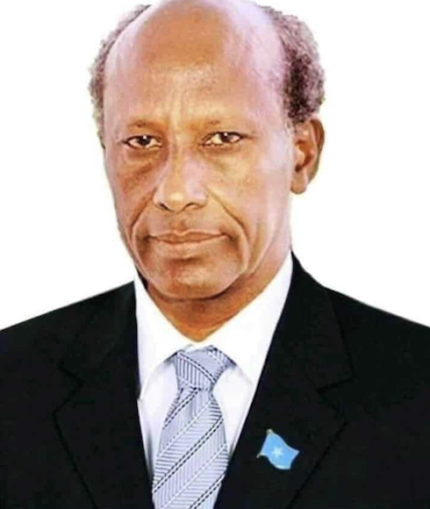
Портрет самопровозглашённого президента,
Administration of Aidid – Public domain
Aidid declared himself President of Somalia in June 1995. However, his declaration received no international recognition [Clinton/Albright moves], his rival Ali Mahdi Muhammad who had already been self-elected interim president at a conference in 1991 in Djibouti was recognized as such by the international community i.e.; the US.
On 24th July 1996, Aidid and his men clashed with the forces of former allies Ali Mahdi Muhammad and Osman Ali Ato. Ato was the financier of Aidid, and of the same subclan. Ato is alleged to have masterminded the subsequent defeat of Aidid. Aidid suffered a gunshot wound in the ensuing battle. He later died from a heart attack on 1st August 1996, either during or after surgery to treat his injuries.
Ali Mahdi Muhammad
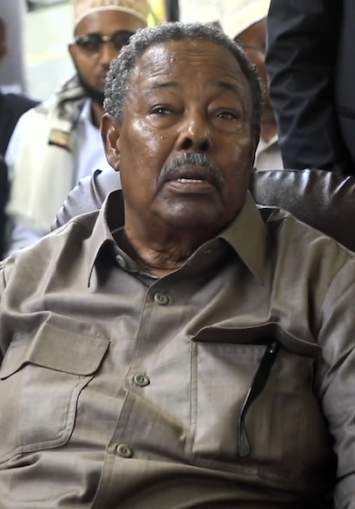
Али_Махди_Мохамед,
Shabelle TV – Public domain
Competition for influence and resources between Ali Mahdi and Aidid continued throughout the 1992–95 United Nations Somalia missions (UNOSOM I, UNOSOM II, and UNITAF), until Aidid’s eventual death in 1996. In 2000, Ali Mahdi participated in another conference in Djibouti, where he lost a re-election bid to Barre’s former Interior Minister Abdiqasim Salad Hassan. Ali Mahdi’s concession speech indicated he respected the outcome of the election, would support and work with the new president-elect.
Ali Mahdi died on 10 March 2021, in Nairobi, allegedly contracting non-existent CONVID post arrival. The Lamestream cover story was a group of Italian Somali tourists had arrived displaying CONVID symptoms. No one in Kenya or Somalia believed that. US Embassy did not comment.
Osman Ali Ato
Ato owned the biggest landed property in Somalia, including many of the buildings in Mogadishu which were rented to relief agencies and the media. Ato also derived significant profits from a tanker-trucking company which operated from a strategically situated yard at Eldoret, north-western Kenya. From there, Ato shipped fuel to Burundi, Rwanda and Uganda. This business was allegedly operated by his relatives. Ato was also a large shareholder in ConocoPhillips oil company that were seeking to extract oil in Somalia. As a result of this connection, he later founded his own oil company and he reportedly acquired a majority shareholding stake in Bluebird Aviation during the early 1990s and imported the lucrative khat from Kenya.
He had been able to acquire trucks and heavy construction machinery, making him the only Somali capable of being a reliable contractor for construction projects by Western companies. Among the Somali country managers of international oil companies, Ato was known as “Monsieur Dozer” because of his ability to cut through the most difficult territory and establish access roads to remote sites. His monopoly made him powerful before other warlords started to ascend and became Aidid’s financier during the civil war. In addition to holding a Somali passport, Ato also had use of passports from Kenya, the United States and Italy. On 5th August, 2013, Ato died of natural causes in his Mogadishu residence.
Qaybdiid – Abdi Hasan Awale
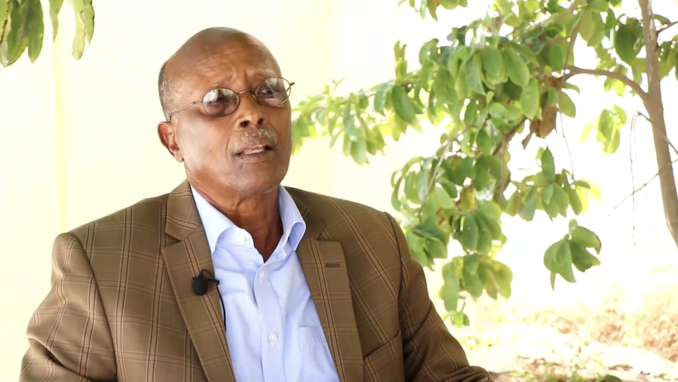
Abdi Hasan Awale, former President of Galmudug,
Shabelle TV – Licence CC BY-SA 3.0
Having risen to prominence as Farrah Aidid’s interior minister, the target of Bloody Monday, Qaybdiid together with Osman Ali Ato were captured during the Day of the Rangers raid and was held in US custody for two months.
In 2001, he was the chief of police over Mogadishu as part of the new Transitional National Government [TNG]. In 2006, he fought with the Alliance for the Restoration of Peace and Counter-Terrorism (ARPCT) against the Islamic Courts Union [ICU] in the 2nd Battle of Mogadishu. They surrendered on 11 July 2006, the last forces to do so. On January 1, 2007, he returned to Mogadishu where he pleaded for there to be no reprisals against the defeated Islamists. In 2012, he became President of Galmudug, an autonomous state of central Somalia until 2015.
© AW Kamau 2023



